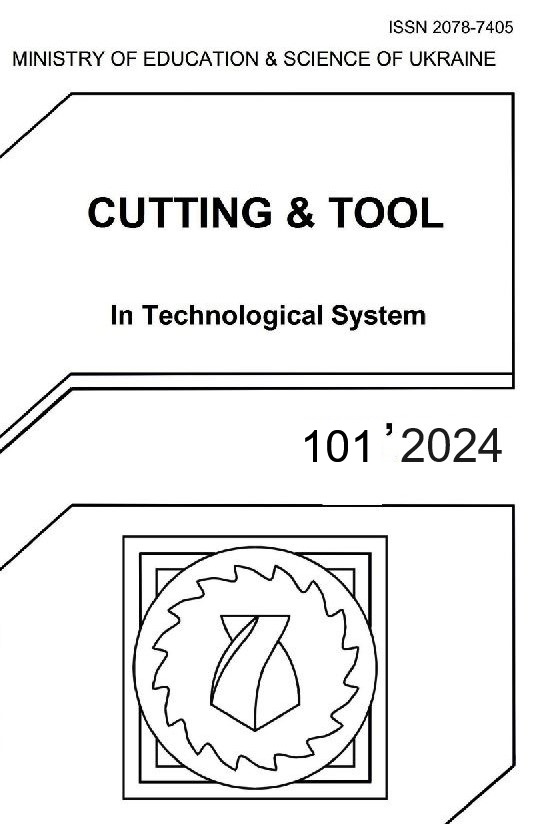INFLUENCE OF HELICAL CUTTING-EDGE ANGLE ON END-MILLING STABILITY
DOI:
https://doi.org/10.20998/2078-7405.2024.101.08Keywords:
milling, milling cutter, thin-walled components, feed rate, oscillogram, accompanying free oscillationsAbstract
Increasing productivity, machining accuracy and efficient use of resources are important priorities for companies that manufacture competitive products. One of the main problems that hinders these processes is the vibration that occurs during cutting. Various methods are used to suppress vibration, one of which is the use of tools with a variable helical cutting-edge angle. However, when choosing the cutting-edge angle, it is important to consider the types of vibrations that occur during cutting, as they directly affect the efficiency of the milling process. In addition, the use of tools with different cutting-edge geometries, such as wavy, gives positive results in roughing, but becomes ineffective in finishing. The purpose of this paper is to study the effect of the helical cutting-edge angle on the stability of the end-milling at different cutting speeds. Both theoretical aspects and experimental data are considered, which make it possible to evaluate the effectiveness of using tools with different angles of inclination to ensure the stability of the machining process and increase productivity while minimizing vibrations in the most unfavorable third speed zone of oscillations for cutting. To conduct the experiments, a special stand was used to adjust the stiffness of the workpiece, record the vibrations that occur during cutting, and the time of contact between the workpiece and the tool. The milling was performed in the third high-speed oscillation zone using a tool whose design provides for the possibility of adjusting the angle of inclination of the helical cutting edge. Studies confirm that changing the angle of inclination can significantly affect the stability of the milling process, reducing the intensity of oscillations and improving machining accuracy. However, this effect depends on the initial cutting conditions, such as the cutting speed. With its increase, the amplitude of the accompanying free oscillations increases, regardless of the value of the angle of inclination. Ensuring the stability of the end-milling in the third speed zone by changing the angle of inclination is possible only at the speeds that determine the beginning of this zone. However, within the entire speed range covered by the third speed zone, it is impossible to ensure a stable milling process only due to the angle of inclination. The study emphasizes the importance of an integrated approach to selecting cutting parameters to achieve process stability.
References
Alan S., Budak E., Ozguven H. Analytical Prediction of Part Dynamics for Machining Stability Analysis. International Journal of Automation Technology. 2010. 4(3). pp. 259–267. doi: 10.20965/ijat.2010.p0259.
Tunc L.T., Budak E. Effect of Cutting Conditions & Tool Geometry on Process Damping In Machining. International Journal of Machine Tools &Manufacture. 2012. 57. pp.10–19. doi: 10.1016/j.ijmachtools.2012.01.009.
Yusoff A.R., Turner S., Taylor C.M., Sims N.D. The Role of Tool Geometry in Process Damped Milling. International Journal of Advanced Manufacturing Technology. 2010. 50(9–12). pp. 883–895. doi: 10.1007/s00170-010-2586-6
Altintas Y., Engin S., Budak E. Analytical Stability Prediction & Design for Variable Pitch Cutters. Journal of Manufacturing Science & Engineering. 1999. 121(2). pp. 173–178. doi: 10.1115/1.2831201.
Sellmeier V., Denkena B. Stable Islands in the Stability Chart of Milling Processes Due To Unequal Tooth Pitch. International Journal of Machine Tools & Manufacture. 2010. 51(2). pp. 152–164. doi: 10.1016/j.ijmachtools.2010.09.007.
Budak E. Improving Productivity & Part Quality in Milling of Titanium Based Impellers by Chatter Suppression & Force Control. CIRP Annals. 2000. 49(1). pp. 31–36. doi:10.1016/S0007-8506(07)62890-X
Stone B.J. Chatter & Machine Tools, Springer International Publishing Switzerland, 2014. 260 p.
Wang J.J., Yang C.S. Angle & Frequency Domain Force Models for a Roughing End Mill with a Sinusoidal Edge Profile. International Journal of Machine Tools & Manufacture. 2003. 43. pp. 1509–1520. doi:10.1016/S0890-6955(03)00163-9.
Munoa J., Zatarain M., Dombovari Z., Yang Y. Effect of Mode Interaction on Stability of Milling Processes. 12th CIRP Conference on Modelling of Machining Operations, San Sebastian, Spain. 2009.
Smith S., Tlusty J. Current Trends in High-Speed Machining. Journal of Manufacturing Science & Engineering. 1997. 119. pp. 664–666. doi:10.1115/1.2836806.
Tobias S.A., Fishwick W. Theory of Regenerative Machine Tool Chatter. The Engineer. 1958. 205 p.
Vnukov Y.N., Dyadya S.I. I., Kozlova E.B, et al. Self-oscillations during milling of thin-walled parts elements. Zaporozhye: ZNTU, 2017. 208 p.
Dyadya S., Vnukov Y., Kozlova O., Trishyn P. Regularities of Oscillations During Turning and End Milling. Grabchenko’s International Conference on Advanced Manufacturing Processes. 2023. pp. 136‒144.
Downloads
Published
Issue
Section
License
Copyright Notice
Authors who publish with this Collection agree to the following terms:
1. Authors retain copyright and grant the Collection right of first publication with the work simultaneously licensed under a Creative Commons Attribution License that allows others to share the work with an acknowledgement of the work's authorship and initial publication in this Collection.
2. Authors are able to enter into separate, additional contractual arrangements for the non-exclusive distribution of the Collection's published version of the work (e.g., post it to an institutional repository or publish it in a book), with an acknowledgement of its initial publication in this Collection.
3. Authors are permitted and encouraged to post their work online (e.g., in institutional repositories or on their website) prior to and during the submission process, as it can lead to productive exchanges, as well as earlier and greater citation of published work.

